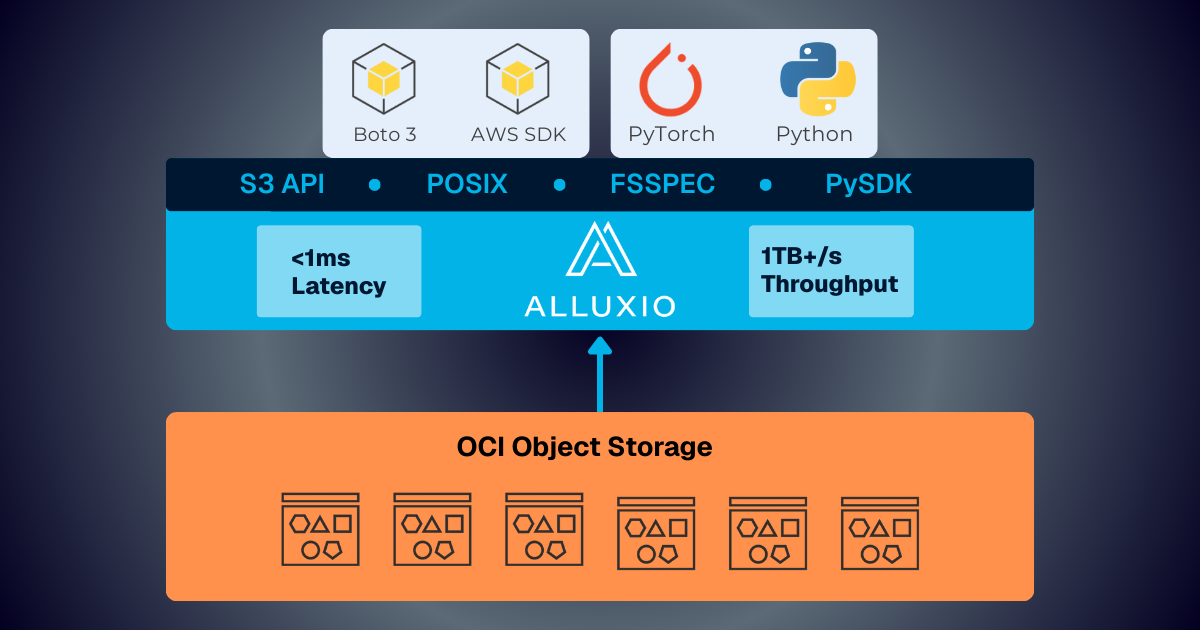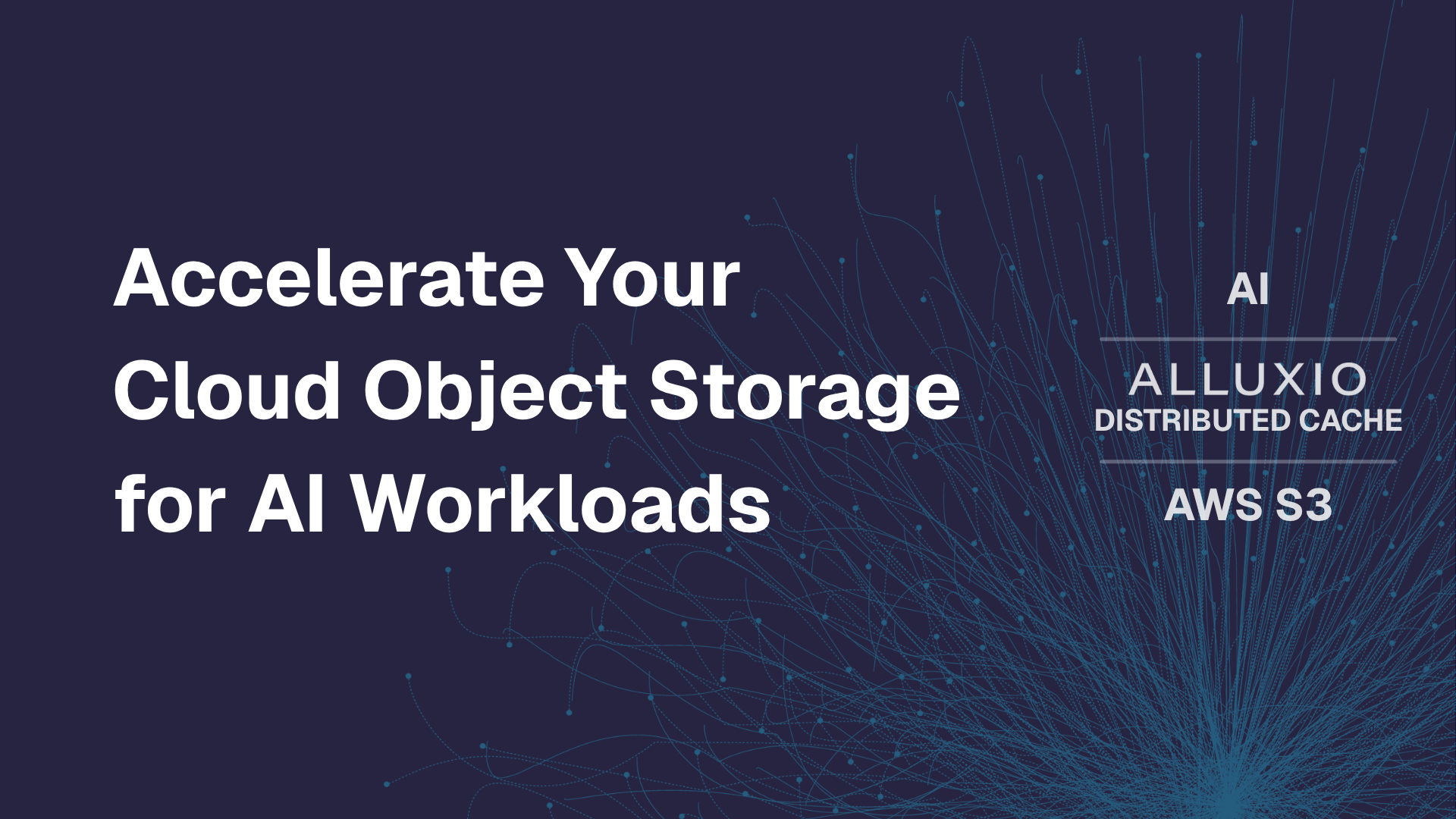Products
Blog

Alluxio and Oracle Cloud Infrastructure: Delivering Sub-Millisecond Latency for AI Workloads
Oracle Cloud Infrastructure has published a technical solution blog demonstrating how Alluxio on Oracle Cloud Infrastructure (OCI) delivers exceptional performance for AI and machine learning workloads, achieving sub-millisecond average latency, near-linear scalability, and over 90% GPU utilization across 350 accelerators.

Make Multi-GPU Cloud AI a Reality
If you’re building large-scale AI, you’re already multi-cloud by choice (to avoid lock-in) or by necessity (to access scarce GPU capacity). Teams frequently chase capacity bursts, “we need 1,000 GPUs for eight weeks,” across whichever regions or providers can deliver. What slows you down isn’t GPUs, it’s data. Simply accessing the data needed to train, deploy, and serve AI models at the speed and scale required – wherever AI workloads and GPUs are deployed – is in fact not simple at all. In this article, learn how Alluxio brings Simplicity, Speed, and Scale to Multi-GPU Cloud deployments.
.png)
Thank you! Your submission has been received!
Oops! Something went wrong while submitting the form.
.jpeg)
Data Consistency Model in Alluxio
Unlike HDFS which provides one-copy update semantics or AWS S3 which provides eventual consistency, data consistency in Alluxio is a bit more complicated and depends on the configuration. In short, when clients are only reading and writing through Alluxio, the Alluxio file system provides strong consistency. However, when clients are writing data across both Alluxio and under storage, the consistency may depend on the write type and under storage type.
No items found.
.jpeg)
Reducing Large S3 API Costs Using Alluxio
This article described how engineers at datasapiens brought down S3 API costs by 200x by implementing Alluxio as a data orchestration layer between S3 and Presto.
Cloud Cost Savings
.jpeg)
Adopting Satellite Clusters with Alluxio at Vipshop to Improve Spark Jobs for Targeted Advertising by 30x
As the third largest e-commerce site in China, Vipshop processes large amounts of data collected daily to generate targeted advertisements for its consumers. In this article, Gang Deng from Vipshop describes how to meet SLAs by improving struggling Spark jobs on HDFS by up to 30x, and optimize hot data access with Alluxio to create a reliable and stable computation pipeline for e-commerce targeted advertising.
Large Scale Analytics Acceleration

Building a Cross-Region Hybrid Cloud Storage Gateway for Machine Learning AI at WeRide
In this blog, Derek Tan, Executive Director of Infra & Simulation at WeRide, describes how engineers leverage Alluxio as a hybrid cloud data gateway for applications on-premises to access public cloud storage like AWS S3.
Hybrid Multi-Cloud
Model Training Acceleration

Introducing Alluxio 2.3
Alluxio 2.3.0 focuses on streamlining the user experience in hybrid cloud deployments where Alluxio is deployed with compute in the cloud to access data on-prem. Features such as environment validation tools and concurrent metadata synchronization greatly improve Alluxio’s functionality. Integrations with AWS EMR, Google Dataproc, K8s, and AWS Glue make Alluxio easy to use in a variety of cloud environments. In this article, we will share some of the highlights of the release. For more, please visit our release notes page.
No items found.
.jpeg)
Accelerating Analytics by 200% with Impala, Alluxio, and HDFS at Tencent
In this article, Honghan Tian describes how engineers in the Data Service Center (DSC) at Tencent PCG (Platform and Content Business Group) leverages Alluxio to optimize the analytics performance and minimize the operating costs in building Tencent Beacon Growing, a real-time data analytics platform.
Large Scale Analytics Acceleration

Efficient Model Training in the Cloud with Kubernetes, TensorFlow, and Alluxio
This article presents the collaboration of Alibaba, Alluxio, and Nanjing University in tackling the problem of Deep Learning model training in the cloud. Various performance bottlenecks are analyzed with detailed optimizations of each component in the architecture. Our goal was to reduce the cost and complexity of data access for Deep Learning training in a hybrid environment, which resulted in over 40% reduction in training time and cost.
Hybrid Multi-Cloud
GPU Acceleration
Model Training Acceleration

Alluxio Accelerates Deep Learning in Hybrid Cloud using Intels Analytics Zoo open source platform powered by oneAPI
This article describes how Alluxio can accelerate the training of deep learning models in a hybrid cloud environment when using Intel’s Analytics Zoo open source platform, powered by oneAPI. Details on the new architecture and workflow, as well as Alluxio’s performance benefits and benchmarks results will be discussed.
Model Training Acceleration
Hybrid Multi-Cloud
Large Scale Analytics Acceleration
.jpeg)
Everything you want to know about how to decouple SQL engines from Hive Data Warehouse
Are you using SQL engines, such as Presto, to query existing Hive data warehouse and experiencing challenges including overloaded Hive Metastore with slow and unpredictable access, unoptimized data formats and layouts such as too many small files, or lack of influence over the existing Hive system and other Hive applications?
Large Scale Analytics Acceleration
Your selections don't match any items.


.jpeg)